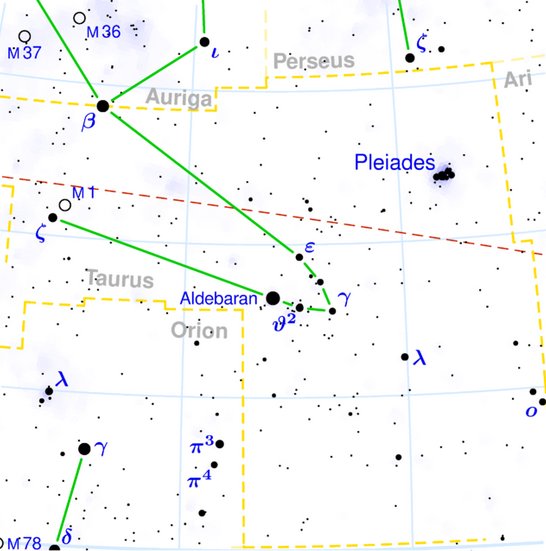
 |
no glyph |
 |
 |
|
Ga1-1 |
Ga1-2 |
|
Hyadum
II
(δ╣ Tauri)
(64.2) |
Net-19 |
no star
listed (66) |
|
AIN,
θ╣ Tauri, θ▓ Tauri
(65.7) |
|
May 24
(5-24) |
25 (*65 + 80 = 145) |
26 (146
+ 366 = 512) |
|
║May 20
(5-20) |
21 (*65
- 4 + 80 = 141) |
22 (142
+ 366 = 508) |
|
'April
27 (4-27) |
28 (*65
- 27 + 80 = 118) |
29 (119
+ 366 = 485) |
|
"April
13 (4-13) |
14 (*65
- 41 + 80 = 104) |
15 (105
+ 366 = 471) |
|
Heart-5 |
ρ Ophiuchi (248.1),
Kajam (248.3), χ Ophiuchi (248.5), She Low, ι Tr.
Austr. (248.7), ζ Tr. Austr. (248.8) |
Al Kalb-16
/
Jyeshtha-18 /
ANA-MUA |
|
σ
SCORPII (247.0), Hejian (247.2), ψ Ophiuchi
(247.7) |
ANTARES (249.1), Marfik, φ Ophiuchi (249.5),
ω Ophiuchi
(249.8) |
|
November
23 (*247) |
24 (145
+ 183 = 328) |
25 (*249 + 80 = 329) |
|
║November 19 (*243) |
20 (141
+ 183 = 324) |
21 (*245
+ 80 = 325) |
|
12 * 12 = 144
and 156 = 12 * 13 = 300 - 144. 12 * 14 = 168 and 300 + 168 =
468 = 12 * 39. |
'October
27 (300) |
28 (118
+ 183 = 301) |
29 (*222
+ 80 = 302) |
|
12 * 15 = 180 and 468 + 180 = 648 = 2 * 324 =
12 * 54 = 24 * 27 = 3 * 216 = 6 * 108. |
"October
13 (*206) |
14 (104
+ 183 = 287) |
15 (*208
+ 80 = 288) |
The distance from the
dates of my assumed heliacal calendar in rongorongo times to the dates in my from the C
text perceived Al Sharatain lunar (nakshatra) calendar
are 300 - 144 = 156 days (not 366 / 2 = 183 days), because
precession had moved the Sun 27 (= 183 - 156) days earlier in the
year (since the time around 71 * 27 = 1900 years previously when the
heliacal and lunar calendars could have been made to 'walk hand in hand'). According to the heliacal calendar
the stars had moved 27 days in the opposite direction (i.e. ahead),
and therefore 300 + 27
- 144 = 183 (= 366 / 2).
However,
the text could also allude to the time when 0h was at the star Bharani (41
Arietis), with Ga1-1 at
"April 14 (which can be written 4-14 and counted as 414 = 9 *
46) - to be compared with 427 (4-27) = 4 * 61 and 413 (4-13) = 4 *
59. According to my reconstructions: in rongorongo times Bharani rose with the Sun 41.4
(cfr 414) days after 0h. Aldebaran came 27 days later, 41 + 27
= 68 days after March 21 (80), i.e. Aldebaran rose with the Sun in
May 28 (148).
Moreover,
from the first year of the Gregorian calendar (1582 A.D.) to 1842
A.D. (which I have used as a possible 'zero'-year for the
rongorongo calendar texts) there are 260 years, and 260 / 71 = ca
3.66 days. Therefore, due to the precession, the stars in 1842 A.D.
must have risen around 4 days later than in the time of Gregorius
XIII. This could explain why the glyph for heliacal Aldebaran (Ana-muri)
was placed not at the beginning of side a but 4 days later:
 |
 |
 |
 |
|
Ga1-3 |
Ga1-4 |
Ga1-5 |
Ga1-6 |
|
no star listed
(67) |
Rohini-4
/
ANA-MURI |
no star listed
(69) |
no star listed
(70) |
|
ALDEBARAN
(68.2), Theemin
(68.5) |
|
May 27 |
28 (*68 = *64 +
4) |
29 |
30 (150) |
|
║May 23 |
24 (*64) |
25 |
26 (146) |
|
'April 30 |
'May 1 (*41 =
*64 - 23) |
2 |
3 (123) |
|
"April 16 (472) |
17 (*27 = *64 -
37) |
18 (108) |
19 |
|
γ Apodis
(250.1), σ
Herculis
(250.3), θ Tr.
Austr. (250.6),
τ Scorpii
(250.7) |
Han (251.0) |
ζ Herculis, η
Tr. Austr.
(252.1), η
Herculis, β
Apodis (252.5) |
Atria (253.9) |
|
November 26
(*250) |
27 |
28 (332) |
29 |
|
║November 22 |
23 |
24 (328) |
25 (*249) |
|
'October 30 |
31 (*224) |
'November 1
(305) |
2 |
|
"October 16 |
17 (*210) |
18 |
19 (292) |
Counting
at
║May 26 (146 = 2 *
73 = 2 / 5 * 365):
5-26
could allude to 52 * 6 =
312 = 4 * 78 = 13 * 24.
*66 = 366
- 300.
|




